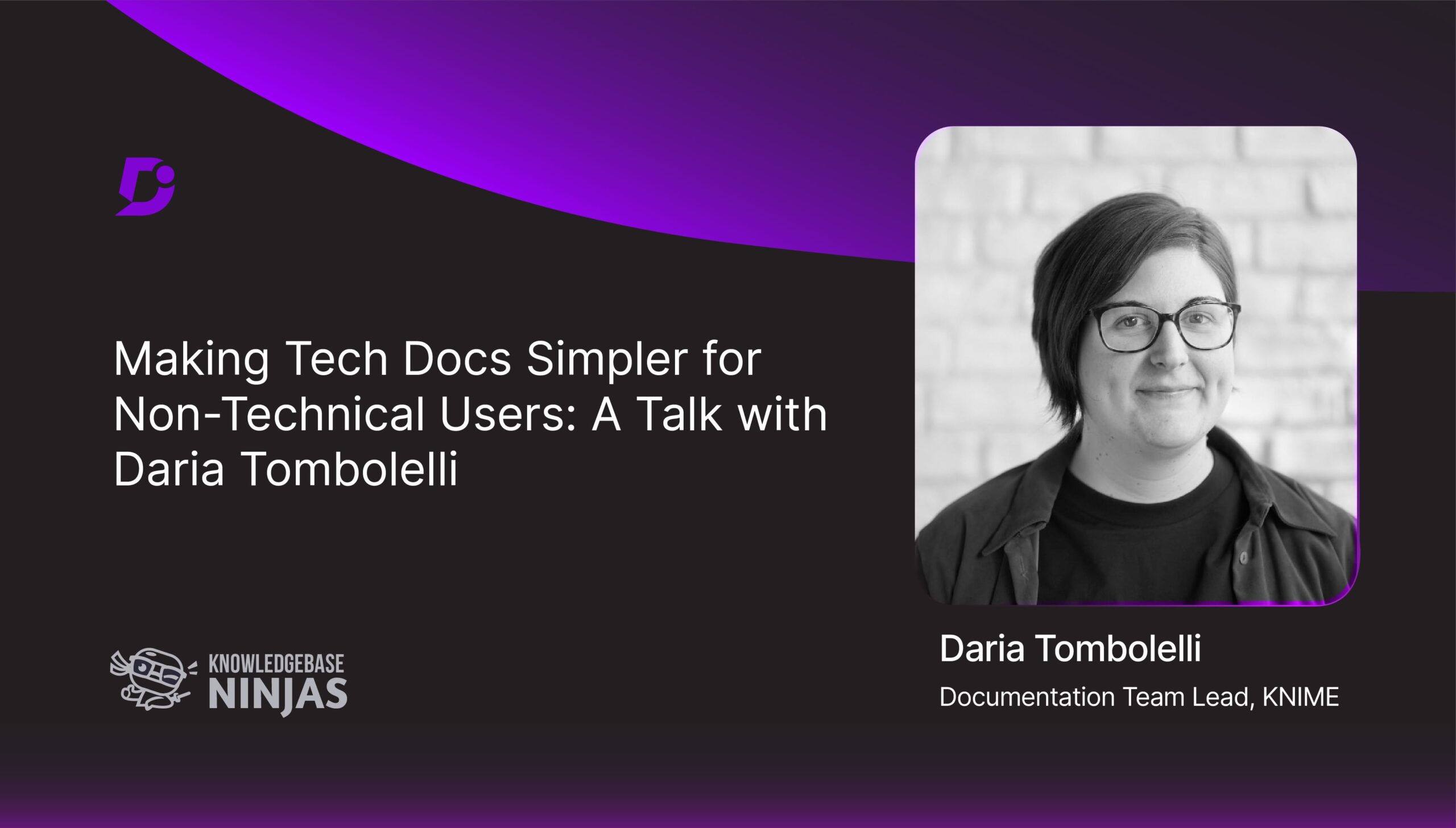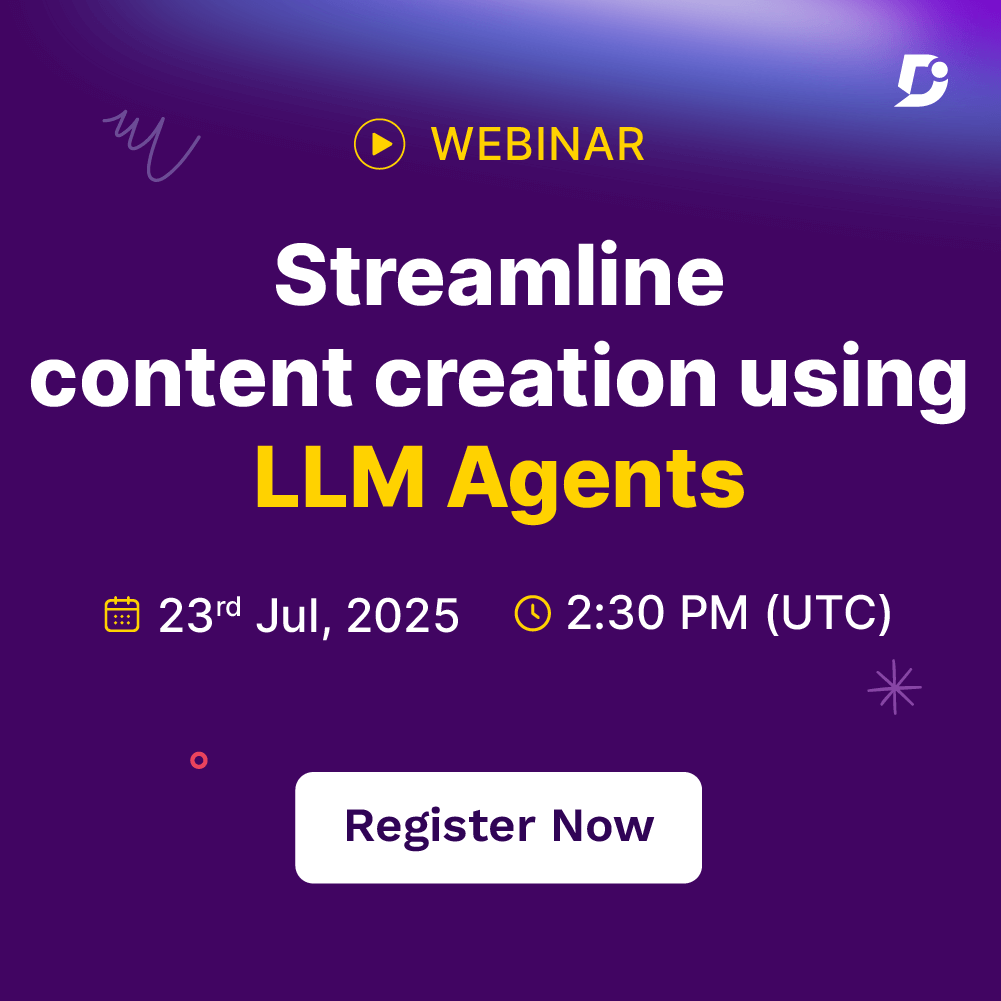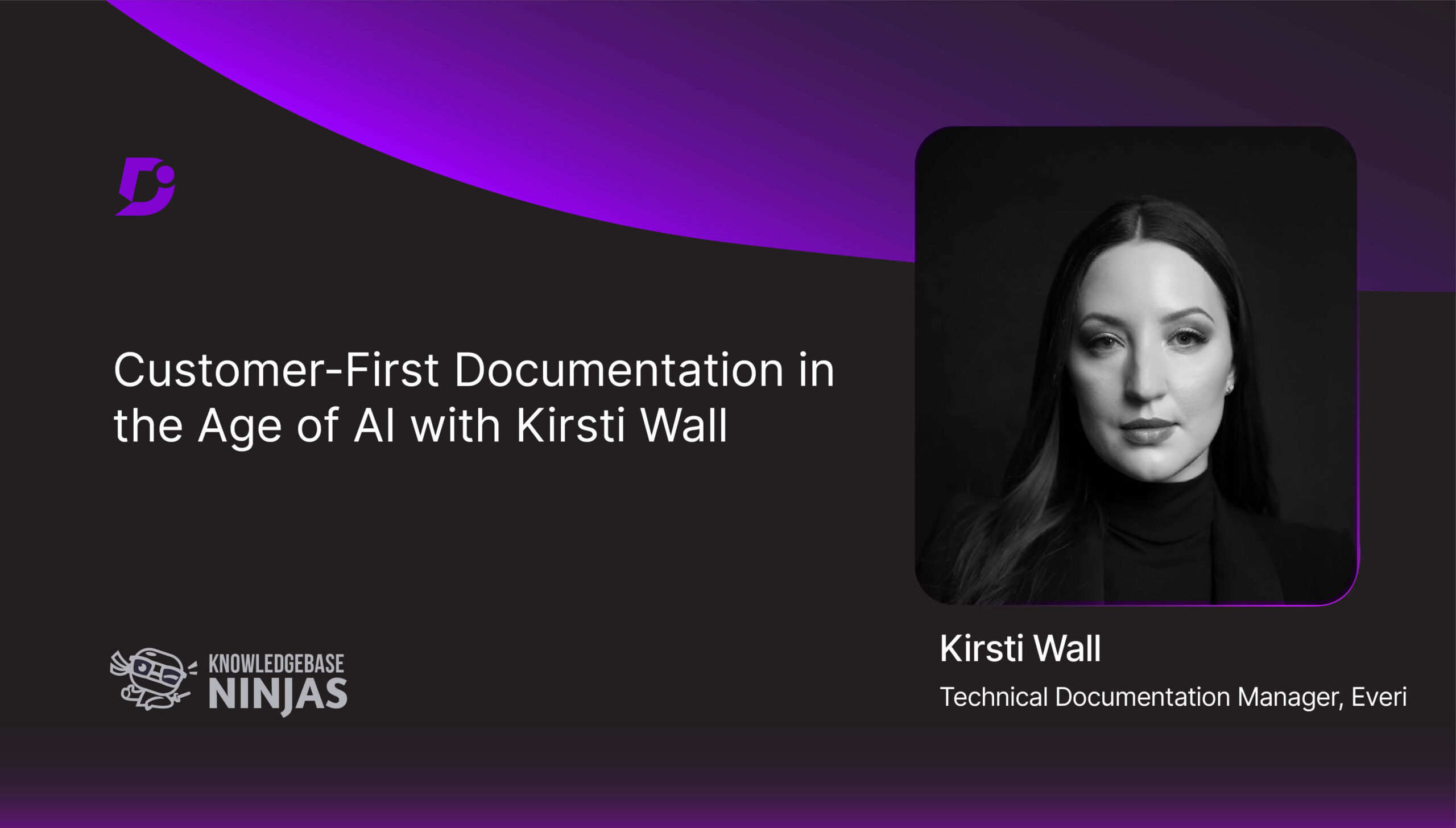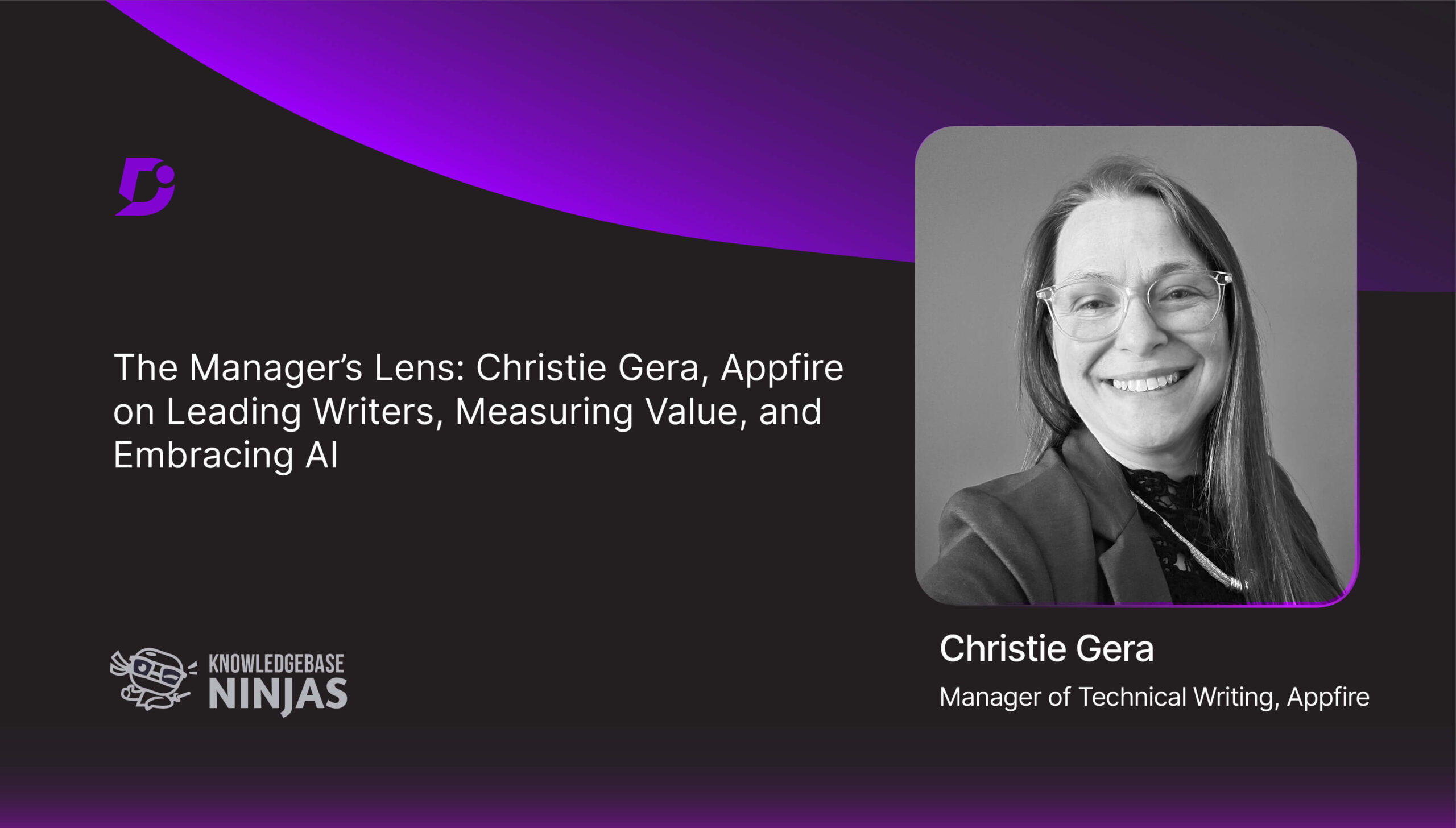In this episode of our Knowledge Base Ninjas podcast, we talk to Christie Gera, Manager of Technical Writing at Appfire. She shares her perspective on how AI is transforming the current state of documentation. She emphasizes the importance of using AI as a creative support tool instead of a content creation tool. From adopting new skills like prompt writing and video editing to using new AI tools, she says that staying adaptable is key. Documentation of a product, when well aligned with user needs, can not only improve the experience but also drive product growth.
Watch the full podcast episode video here
You can listen to the full episode on Apple, Spotify and YouTube.
About Daria
-
Daria’s LinkedIn
-
Daria Tombolelli is a Technical Writer and Documentation Team Lead at KNIME and is currently working in the software field covering data science and AI. Having more than 10 years of experience in scientific research (focusing on computational chemistry), she decided to switch to technical writing as she gained more interest in defining and developing software and data-based technologies.
Quick jumps to what’s covered:
4:25 – How AI is changing the role of technical writers
7:10 – Types of documentation handled in the organization
8:28 – Making technical content accessible for non-technical users
10:43 – Reviewing documentation for user experience
Transcript:
-
01:29 – 04:16 –Daria’s Journey into Technical Writing
Gowri Ramkumar: Now, please help us explain a little bit about yourself. How did you get into this professional journey and how are you keeping yourself very active and motivated?
Daria Tombolelli: Yes. Great. Actually I, coming from a completely different background, I have studied chemistry in my bachelor, master, and I’ve done a PhD in the chemistry and, after that, I was a bit very, a bit looking into, like, data science and, all the new, at least at that time, machine learning, things happening around. And, I tried to apply them into my job as a chemist.
But I got always, very interested in everything related to software and software development, and so I started looking for something else. And, at some point, I found this company that, was very interesting that I’m working at, right now with a software company in the data science analytics, and AI field. And I really wanted to join them. And there was basically a position open or actually, that was covered by someone else that was a developer at that time, who had a lot of other things. The company was growing at that time as well on his end, hence, and so I was asked if I would be interested in being a technical writer? And I was like, I will say that I actually, one of my, blog posts that I published some time ago, I always answered, let me Google that first. So my, I did not know about, about technical writing, at all. And I found very interesting, communities and, very interesting articles.
So that’s, I was like, okay, this sounds, really appropriate to what I have been doing also so far because, I mean, in the scientific field, we write a lot of papers. Of course, it’s very different. So I had to make, quite a shift. But, Yeah, I was, I mean, very interested in the field. And so I decided to start. And since then, it’s been quite a journey.
I’ve learned, very, very, many things, from the community. As you notice, I have the Write The Docs shirt. The community is very, very, active. And I am always amazed by, how much knowledge is, it’s shared. I mean, we are there for the knowledge, right? So, yeah, this seems like the right thing. Yeah.
-
04:16 – 08:27 –The Role of AI in Technical Writing
Gowri Ramkumar: Thank you.And again, thank you once again for being part of this, episode and sharing your valuable experience to the audience today. Now, as a technical writer, how do you think your role has changed with all the AI that’s evolving now and also with the self serving platforms?
Daria Tombolelli : Yeah.So, I have to say that I have been one of the first people, being super interested in the AI and in the company, because I saw that would be a very big help. So mostly, of course, like, there is a lot of talking about, is AI going to take our jobs or whatever? But, I absolutely think that actually AI is just going to and it is already making our job much easier. It’s, much easier for me, for example, to understand, at least, at the beginning, like some of the concept that maybe I have no knowledge about yet.
And sometimes I just have a conversation with ChatGPT and ask, Hey, what is this, terminology means? Or can you give me a summary of something? And, I mean, this is this is just really amazing. And it’s made my job way easier and faster and, yeah. So it has really, changed, so much and, of course, also having the AI directly implemented or very close to the platform that we use, to the software that we use is very, very much important.
On the other side, of course, it’s also, very interesting to see how we are changing how we write, actually the documentation. So not, specifically practically how we write it. So our day to day work, but like how we kind of make our documentation AI ready.
So this is a lot of, also talking about this topic. And I have looked into that and there is one sentence that I’ve heard in some YouTube video. I think, about the topic specifically for technical writing. And it was that, in the moment in which we write for the user, we are also going to write for the AI because that’s how, that’s like the most important, important part so that we have clarity that we have. So to all the things that we have been doing so far.
Yeah, it’s very easy to adapt them to AI as well.
Gowri Ramkumar: That’s a nice, way to put it. Like when you’re writing the documentation, it’s not only for the users, but also hopefully moving forward for the AI too. Yeah. Understand it correctly. Nicely said, Daria. So that brings me to my next question, is, like what kind of documentation do you produce for the current organization? Is it a product documentation?
Daria Tombolelli : Yeah. So, I’m taking care of, so the team is taking care of all the user facing documentation. So we have different products that we work with, and that we develop at the company and, one of them is more on open source software. And it’s also very much community based. So there is a lot of feedback coming in from the community, and there is community developers. So there is also some interactions with the community. And then there is other software that we have that instead are enterprise software and they are much more also, advanced on the technology. So we have a lot of, very, yeah, very complex documentation as well, but it’s all user facing documentation that we take care of more than, like, internal, or, documentation or, yeah, for our, specifically for our developers.
This is a bit out of the scope for the team in this case.
-
08:27 – 10:43 -Making Technical Content Accessible
Gowri Ramkumar : Alright. So in that sense, can you share some practical tips for making complex technical content but more accessible to non-technical users?
Daria Tombolelli : Sure. Yeah.I mean, it’s very, it’s very difficult, especially, when the writer is not as technical as the developer, of course, that there is a, I call it a translation work right from the development language to that very highly specific language as well to something that is more understandable.
Understandable, but still correct, of course. So what I usually do is, as I was saying earlier, especially in the last couple of years, if there is some knowledge that I don’t have, I try always to have a brief conversation with ChatGPT, for example, and ask to give me kind of the basic knowledge of a specific topic. And, then from there, I always try to, if there is something that I can test or that I can try practically, with our software, for example, let’s say the installation of our software so that I can try it myself.
And then I usually, ask developers and, or our internal, also, support agents, for example, and ask for, having a call and seeing how this practically works, especially our support engineers that work with our customers, hand in hand. And, they produce a lot of documentation that explains what they did. Maybe it’s very specific to a specific case, or a specific installation that they did, for example.
But I try to always get that as, also as a feedback, to what we have. So I try to be as much as possible open to seeing firsthand how things are done.
And then try to, yeah, make it into something that is understandable. And, Yeah. Not oversimplified, of course, but, simple enough for the specific user that we are, that we have in mind for that specific guide, for example.
-
10:43 – 12:30 –Reviewing for User-Friendliness
Gowri Ramkumar: Nice. Now, relating to that, any signs that you can, you spot when reviewing the documentation and you feel like, um, that doesn’t sound very user-friendly?
Daria Tombolelli : I always try also to look at it from an experience point of view. So always also try to see how the guide, for example, looks on the page, and try of course, other than looking at the terminology, but I think that how the documentation looks on the page is very, very important.
So I look for longer sentences and places where I feel like I wouldn’t be able to follow if I were to be, someone that just want the specific information in that specific bit of the guide and wants to know how to get from A to B and doesn’t need to know, too many other information.
And I always try also to look at it from let’s say, information architecture point of view, right? So how they got there and how they, they see the information on the page.
So, yeah, in that sense, having also I collaborate a lot also with the UX team, and that since they taught me so much about how users interact with, what they see, right? So that’s, very, very interesting. And that’s something I always try to put myself into the shoes of the reader.
Gowri Ramkumar: Absolutely. Like I said. Yeah. That’s one great way to see how your content is being consumed and experience the way the users will experience your own content. Right? Daria Tombolelli Yeah. Yeah. Exactly.
-
12:30 – 13:43 –⚡ Rapid Fire Round
Gowri Ramkumar: Super. Now, let me just go with some rapid fire round questions, if that’s okay with you. And looks like you read a lot of content just by looking at the t-shirt that you are wearing.
Daria Tombolelli : Yes!
Gowri Ramkumar: Any valuable documentation related resources you can highlight to us today, please?
Daria Tombolelli: Yes. Actually, of course I have, there is so much content which, as you were saying, one content, one person actually, I always follow on LinkedIn is Fabrizio Benedetti and, their blog is punto.uno (passo.uno), I think. And, they have a lot, and, a lot of, very useful content and, yeah, I recently read one of the posts that talks about, like, their point of view on what is going to come in 2025 for documentation. And I found that very, very interesting.
Gowri Ramkumar: Thank you. So now what is that one word that comes to your mind instantly when, we say “Documentation”?
Daria Tombolelli: As I was saying earlier I would say experience.
Gowri Ramkumar : Okay.A piece of advice you would get your 20 year old self? Daria Tombolelli :Get into the field earlier.
-
13:43 – 14:55– Final Thoughts
Gowri Ramkumar: Okay. Nice one. Now, I know you’ve got ample amount of experience and, things to share, but I try to see what is the latest trend and what could be of valuable to our audiences. But, Daria, if there is anything else you would like to add that I missed to ask you, please feel free to speak out now. Please.
Daria Tombolelli : Sure. Just one thing. If anyone is thinking about getting into the field and, as, a bit of unsure, or uncertainty about what is, how it is and how it is to work as a technical writer, I really, really highly recommend it. Because this has been, a very interesting journey, and there is a lot to learn and, Yeah. So please become a technical writer. It’s very, it’s a very nice job.
Gowri Ramkumar: Nice.You’ve already developed a chemistry between you and documentation then. Yes. Fantastic. So lovely talking to you, Daria. And all the very best for the current project and for all your future projects as well. And, keep innovating and, raising yourself up with the all the AI innovations.
Daria Tombolelli: Thank you.
Gowri Ramkumar: Thank you. Take care.
Disclaimer: This transcript was generated using AI. While we aim for high accuracy, there may be minor errors or slight timestamp mismatches.
Enjoyed this conversation?
Explore the future of knowledge sharing in our Knowledgebase Ninjas Podcast — featuring insights from documentation leaders and industry experts. Subscribe for the latest episodes, and if you found this helpful, pass it to your colleagues!
📘 Read Our eBook
Discover how AI is shaping the future of technical writing:
The Future of Technical Writing – AI’s Impact on Knowledge Management
🎙️ Watch Webinars
Learn from experts and product specialists in our Webinar Library
🏆 Explore Case Studies
See how leading teams are using Document360 to build powerful knowledge bases:
Customer Success Stories
📚 Browse Resources
Access our full Resource Library — including blogs, videos, guides, and more.
🧪 Try Document360 for Free
Experience how top teams create world-class documentation with ease.
Start Your Free Trial
📲 Follow Us for Updates, Tips & Best Practices
🔗 LinkedIn | 🐦 Twitter (X) | 📘 Facebook | 📸 Instagram | ▶️ YouTube





 –
– 

